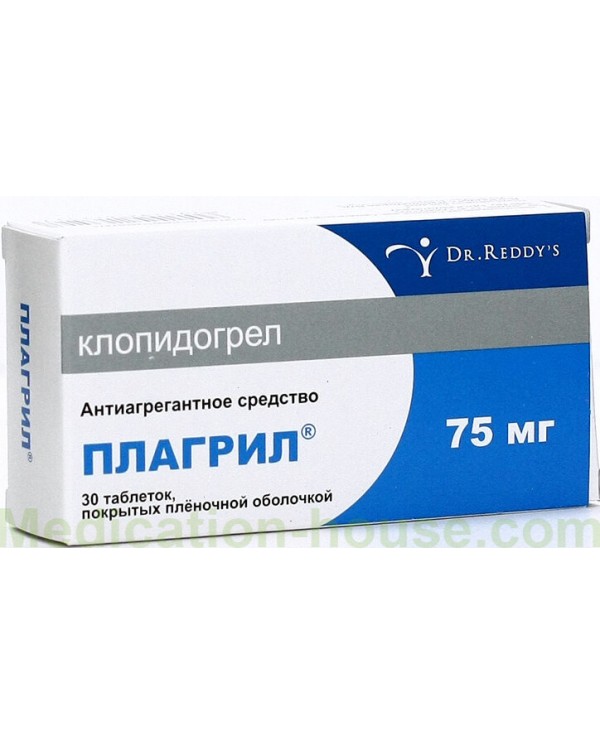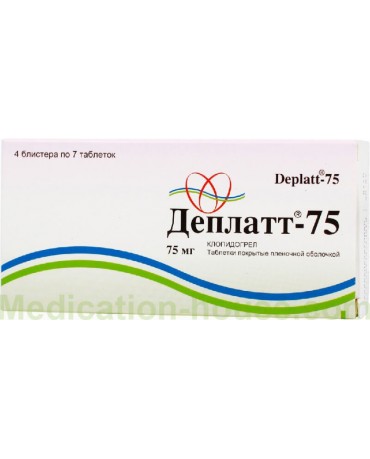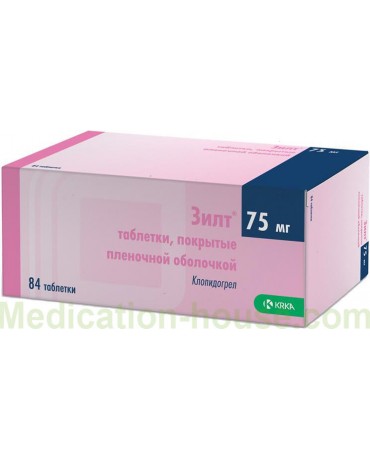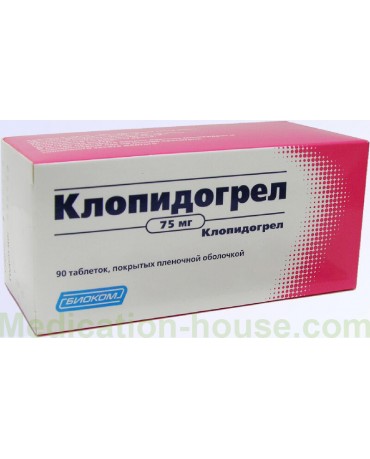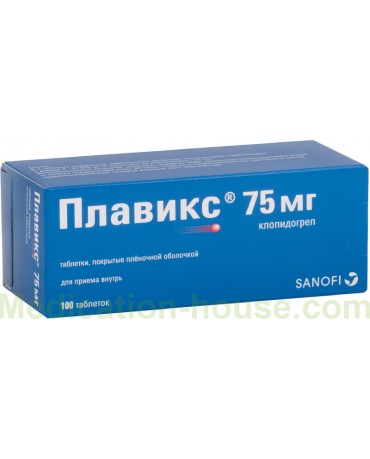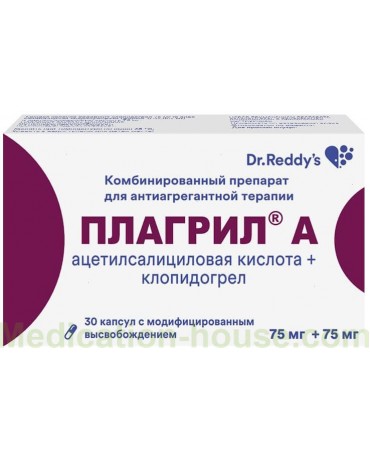Instruction for use of Plagril
You can buy Plagril on this page
Plagril is an antiplatelet drug.
Release form and composition
Dosage form Plagril - film-coated tablets: round, biconvex, pink, embossed on one side "C 127" (10 pieces in a blister, in a cardboard box 3 or 10 blisters).
Composition of 1 tablet:
active substance: clopidogrel hydrosulfate - 97.875 mg (corresponds to the content of clopidogrel - 75 mg);
auxiliary components: microcrystalline cellulose (Avicel PH 112), mannitol, croscarmellose sodium, colloidal silicon dioxide, magnesium stearate;
film shell: pink opadry 03В54202 (titanium dioxide, hypromellose, macrogol-400, dye iron oxide red).
Pharmacodynamics
Clopidogrel bisulfate is a specific inhibitor of platelet aggregation. It has a weakening effect on the adhesion of platelets to each other by selectively reducing the binding of adenosine diphosphate (ADP) to receptors located on platelets and activating GPIIb / IIIa receptors. By reducing platelet aggregation caused by other agonists, clopidogrel prevents their activation by released ADP, without affecting the activity of phosphodiesterase (PDE). After 2 hours after taking the initial dose of 400 mg, platelet aggregation is inhibited. The maximum effect is achieved within 4–7 days, with constant administration of the drug at a dose of 50–100 mg / day. The effect lasts for 7-10 days. After Plagril was discontinued within 5 days, bleeding time and platelet aggregation returned to the initial level.
Clopidogrel prevents the development of atherothrombosis in patients with atherosclerotic vascular lesions (cerebrovascular, cardiovascular or peripheral).
Pharmacokinetics
Plagril is highly absorbed and bioavailable. Plasma concentration is low. Metabolism of clopidogrel bisulfate occurs in the liver. The main metabolite is an inactive derivative of carboxylic acid. The maximum concentration of the metabolite after repeated oral administrations of the drug at a dose of 75 mg is achieved within an hour and is 3 mg / l. The active metabolite of clopidogrel is a thiol derivative (not found in plasma), formed by its oxidation to 2-oxo-clopidogrel and subsequent hydrolysis. It quickly and irreversibly binds to platelet receptors and inhibits platelet aggregation.
Clopidogrel is eliminated by the kidneys (50%) and intestines (46%). T1 / 2 (half-life) of the main metabolite is 8 hours.
In patients with severe kidney disease, the concentration of the main metabolite in plasma when taking the drug in a daily dose of 75 mg is lower than in moderate kidney disease and in healthy patients.
Indications for use
Plagril is recommended for the prevention of thrombotic complications in the following diseases / conditions:
myocardial infarction, ischemic stroke, or peripheral arterial occlusion;
acute coronary syndrome: with ST segment elevation, if thrombolytic treatment is possible; without ST segment elevation (with unstable angina pectoris, myocardial infarction without the formation of a Q wave), including after vascular stenting surgery - in combination with acetylsalicylic acid.
Contraindications
Absolute contraindications:
severe liver failure;
hemorrhagic syndrome;
acute bleeding (including intracranial) and diseases that increase their risk, such as peptic ulcer and 12 duodenal ulcer in the acute stage, ulcerative colitis, tuberculosis, lung tumors, hyperfibrinolysis;
age under 18;
pregnancy and breastfeeding period;
increased sensitivity to the components of Plagril.
Relative contraindications:
hepatic / renal failure of moderate severity;
injuries, conditions after surgery, and others that increase the risk of bleeding;
simultaneous administration of NSAIDs (non-steroidal anti-inflammatory drugs) (including inhibitors of cyclooxygenase COX-2), acetylsalicylic acid, heparin, inhibitors of glycoprotein IIb / IIIa.
Instructions for use of Plagril: method and dosage
Plagril tablets are taken orally, once a day, regardless of food intake.
Recommended dosage according to indications:
prevention of thrombotic complications no later than 35 days after myocardial infarction, and 1-25 weeks after ischemic stroke, with established peripheral arterial diseases: 75 mg / day;
acute coronary syndrome without ST elevation: initial dose - 300 mg, then 75 mg / day, in combination with acetylsalicylic acid (75-325 mg / day). The use of high doses of acetylsalicylic acid increases the risk of bleeding, and therefore the recommended dose should not exceed 100 mg. Duration of taking the drug - 12 months;
acute coronary syndrome with ST segment elevation: 75 mg / day, using an initial loading dose in patients younger than 75 years old, and in combination with acetylsalicylic acid, in combination with or without thrombolytics. Plagril is taken as early as possible after the onset of symptoms and continues for up to 4 weeks.
Side effects
coagulation system of the blood: bleeding from the gastrointestinal tract (GIT), hemorrhagic stroke, prolongation of the duration of bleeding, hematomas, hematuria, conjunctival bleeding;
hematopoietic system: thrombocytopenia, neutropenia, leukopenia, eosinophilia, thrombocytopenic purpura, granulocytopenia, agranulocytosis, anemia, aplastic anemia;
central and peripheral nervous system: headache, dizziness, paresthesia, vertigo, confusion, hallucinations;
cardiovascular system: vasculitis, lowering blood pressure (BP);
respiratory system: bronchospasm, interstitial pneumonitis;
digestive system: dyspepsia, abdominal pain, diarrhea, nausea, vomiting, gastritis, flatulence, constipation, ulceration of the gastrointestinal mucosa, ulcerative lesions of the stomach and duodenum (exacerbation), pancreatitis, colitis (including ulcerative or lymphocytic), stomatitis , violation of taste, hepatitis, increased activity of liver enzymes, acute liver failure;
musculoskeletal system: arthralgia, myalgia, arthritis;
urinary system: glomerulonephritis;
dermatological reactions: itching, bullous rash (erythema multiforme, Stevens-Johnson syndrome, toxic epidermal necrolysis), erythematous rash, eczema, lichen planus;
allergic reactions: urticaria, angioedema, serum sickness, anaphylactic reactions;
other reactions: an increase in temperature and an increase in the level of creatinine in the blood.
Overdose
When taking 600 mg of clopidogrel in healthy people, no symptoms of overdose were found. The bleeding time in this case is equivalent to the bleeding time when taking therapeutic doses of the drug.
No specific antidote known. In case of overdose, platelet transfusion is indicated.
Special instructions
The drug should be discontinued 7 days before surgical interventions in which an antiplatelet effect is undesirable.
You should inform your doctor about any case of unusual bleeding while taking the drug. In addition, if the patient is to undergo surgery or a new drug is prescribed, the doctor should be informed about the intake of Plagril.
During therapy, it is necessary to monitor the functional activity of the liver and indicators of the hemostasis system: activated partial thromboplastin time (APTT), platelet count, tests of platelet functional activity.
Influence on the ability to drive vehicles and complex mechanisms
There is no data on the effect of Plagril on the ability to drive vehicles and other complex mechanisms that require the speed of psychomotor reactions.
With impaired renal function
Plagril 75 mg should be used with caution in moderate renal impairment.
If liver function is impaired
According to the instructions, Plagril should be used with caution in moderate hepatic impairment. Patients with severely impaired liver function during clopidogrel therapy are at risk of developing hemorrhagic diathesis.
Drug interactions
acetylsalicylic acid, heparin, indirect anticoagulants, non-steroidal anti-inflammatory drugs: their antiplatelet effect increases, the risk of bleeding from the gastrointestinal tract increases;
drugs metabolized by CYP2C9 (phenytoin, tolbutamide): the concentration of these drugs increases;
estrogens, nifedipine, cimetidine, phenobarbital, digoxin, theophylline, tolbutamide, atenolol, antacids: their clinically significant interaction with clopidogrel was not noted.
Terms and conditions of storage
Store in a dry place, away from light, at a temperature not exceeding 25 ° C. Keep out of the reach of children.
Shelf life is 2 years.
Reviews
Reviews of Plagril on the Internet are positive. Patients note its effectiveness in the prevention of thrombus formation after heart attack and stroke.
Terms of sell
You can buy Plagril without a prescription.

